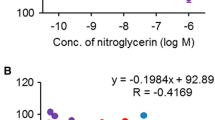Summary
To compare the antiischemic effects of intracoronary administration of a beta blocker, atenolol, and of a calcium antagonist, nifedipine, on the clinical and electrocardiographic signs of myocardial ischemia induced by balloon occlusion of the coronary artery, we studied 32 consecutive patients undergoing routine PTCA. In each patient at least three balloon inflations were performed: the first served to verify the occurrence of ischemia (ST segment depression/elevation >1.5 mm); the second was used as a control occlusion; the third was performed after the patients were assigned to receive either atenolol 1.0 mg IC (group 1, N=16) or nifedipine V=0.2 mg IC (group 2, N=16). In a control population of 10 patients, the time to return to baseline of the ECG tended to be progressively shorter during the three consecutive inflations, but the other clinical and ECG parameters did not change significantly. In group 1 and group 2, two patients did not show ECG signs of ischemia at the third inflation; the time to ischemia increased in group 1 (+76%, p < .001) and group 2 (+85%, p < .01; NS group 1 versus group 2); ST segment displacement at 30 seconds decreased in group 1 (-38%, p < .01) and group 2 (-36%, p < .01; NS group 1 versus group 2). In group 1, 2/16 patients were symptom free, and the time to chest pain was significantly delayed (+47%, p < .01) at the third inflation; in group 2 no patient became asymptomatic at the third inflation, and the time to chest pain did not change (+5%, NS; NS group 1 versus group 2). In conclusion, the regional cardioplegia obtained through the blockade of the slow calcium channels with IC nifedipine or of the beta receptors with IC atenolol reduced myocardial ischemia to a similar extent during ballon occlusion of the coronary artery. Atenolol was also very effective on chest pain, though not significantly more than nifedipine.
Similar content being viewed by others
References
Kaltembach M, Beyer J, Walter S, et al. Prolonged application of pressure in transluminal coronary angioplasty. Cathet Cardiovasc Diagn 1984;10:213–219.
Zalewsky A, Goldberg S, Dervan JP, et al. Myocardial protection during transient coronary artery occlusion in man: Beneficial effects of regional β-adrenergic blockade. Circulation 1986;4:734–739.
Feldman RL, MacDonald RG, Hill JA, et al. Effects of propranolol on myocardial ischemia occurring during acute coronary occlusion. Circulation 1986;73:727–733.
Doorey AJ, Mehmel HC, Schwartz FX, Kubler W. Amelioration by nitroglycerin of left ventricular ischemia induced by percutaneous transluminal angioplasty: Assessment by hemodynamic variables and left ventriculography. J Am Coll Cardiol 1985;6:267–272.
Feldman RL, Joyal M, Conti R, Pepine CJ. Effects of nitroglycerin on coronary collateral flow and pressure during acute coronary occlusion. Am J Cardiol 1984;54:958–963.
Kern MJ, Deligonul U, Labovitz A, et al. Effects of nitroglycerin and nifedipine on coronary and systemic hemodynamics during transient coronary artery occlusion. Am Heart J 1988;115:1164–1170.
Serruys PW, van der Brand M, Brower RW, Hugenholtz PG. Regional cardioplegia and cardioprotection during transluminal angioplasty, which role for nifedipine? Eur Heart J 1983;4(Suppl C):115–121.
Pop G, Serruys PW, Piscione F, et al. Regional cardioprotection by subselective intracoronary nifedipine is not due to enhanced collateral flow during coronary angioplasty. Int J Cardiol 1987;16:27–41.
Kern MJ, Delingoul U, Gabliani G, et al. Systemic and coronary hemodynamic effects of intra-venous diltiazem in patients during transient myocardial ischemia. 25th Annual International Symposium on Calcium Channel Blockers and Hypertension. J Cardiovasc Pharmacol 1988;12(Suppl 6): 5171–5172.
Hanet C, Rousseau MF, Vincent M, et al. Myocardial protection by intracoronary nifedipine during percutaneous transluminal coronary angioplasty. Am J Cardiol 1987;59: 1035–1041.
Frishman WH, Koch-Weser J. β-adrenoceptor antagonists: New drugs and new indications. N Engl J Med 1981;6: 500–506.
Gold HK, Leinbach RC, Maroko PR. Propranolol-induced reduction of signs of ischemic injury during acute myocardial infarction. Am J Cardiol 1976;38:689–695.
Waagstein F, Hjalmarson AC. Double-blind study of the effect of cardioselective beta-blockade on chest pain in acute myocardial infarction. Acta Med Scand 1976;587(Suppl): 193–200.
Ramsdale DR, Faragher EB, Bennett DH, et al. Ischemic pain relief in patients with acute myocardial infarction by intravenous atenolol. Am Heart J 1982;103:459–467.
International Collaborative Study Group: Reduction of infarct size with the early use of timolol in acute myocardial infarction. N Engl J Med 1984;310:9–15.
Herlitz J, Hjalmarson A, Holberg S, et al. Effect of metoprolol on chest pain in acute myocardial infarction. Br Heart J 1984;51:438–444.
Kralios FA, Martin L, Burgess MJ, Millar K. Local ventricular repolarization changes due to sympathetic nervebranch stimulation. Am J Physiol 1975;228:1621–1626.
Author information
Authors and Affiliations
Rights and permissions
About this article
Cite this article
Ghio, S., De Servi, S., Angoli, L. et al. Similar antiischemic effects of intracoronary atenolol and nifedipine during brief coronary occlusions in humans. Cardiovasc Drug Ther 6, 255–259 (1992). https://doi.org/10.1007/BF00051147
Issue Date:
DOI: https://doi.org/10.1007/BF00051147




